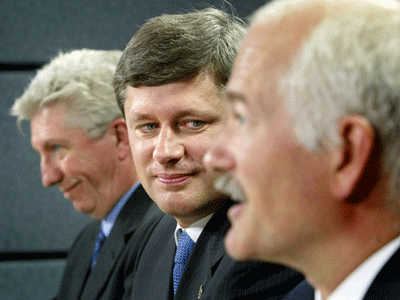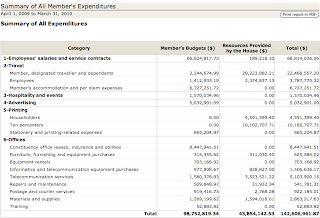
 Now that Canada is once again in the middle of a federal election, I recalled a news item that I had read nearly a year ago about a proposal from the Harper government. In this proposal, the Conservatives plan to increase the number of seats in the House of Commons by 30 from 308 to 338. I searched and found the actual "Legislative Initiative" Bill C-12 entitled An Act to amend the Constitution Act, 1867 (Democratic Representation)on the Federal Government’s Democratic Reform website. For further information, here’s the text of the debate in the House and here’s the text of the Bill which reached second reading on March 22, 2011.
Now that Canada is once again in the middle of a federal election, I recalled a news item that I had read nearly a year ago about a proposal from the Harper government. In this proposal, the Conservatives plan to increase the number of seats in the House of Commons by 30 from 308 to 338. I searched and found the actual "Legislative Initiative" Bill C-12 entitled An Act to amend the Constitution Act, 1867 (Democratic Representation)on the Federal Government’s Democratic Reform website. For further information, here’s the text of the debate in the House and here’s the text of the Bill which reached second reading on March 22, 2011.Rather than taking the time to type out the promotional blurb for the Bill, here is what Minister of State for Democratic Reform Steven Fletcher had to say:
"Our government is following through with its Throne Speech commitment to restoring the principle of representation by population in the House of Commons. If passed, this legislation will give fair representation to the provinces of Alberta, British Columbia and Ontario, while protecting the seat counts of the other provinces."
The current formula for assessing the distribution of representation in the House was implemented in 1985 by the Mulroney government in an attempt to "temper the overall growth of the size of the House of Commons". Since that time, the provinces with faster growing populations (think Alberta, British Columbia and Ontario) have been penalized and have become under-represented in the House of Commons with slower growing provinces benefiting at their expense (if there really is such a thing as benefiting by having an MP who sits in the peanut gallery at the back of the House). This has resulted in MPs from Ontario, Alberta and British Columbia representing an average 26,500 more constituents than MPs from other provinces and this is projected to increase to 29,000 after readjustment.”
On the face of it, the logic looks sound. Thanks to the election, it looks like this Bill died a premature death along with a great deal of other tabled legislation according to the Parliament of Canada website.
Bill C-12 proposed that the electorate in the provinces of Alberta, Ontario and British Columbia were not fairly represented since the population growth of each of the provinces had risen well above the national average while the number of MPs had remained the same, that is to say that the concept of representation by population was not consistent across Canada. In the proposed readjustment, Ontario would receive 18 new seats, Alberta would receive 5 and British Columbia would receive 7. The number of seats in the remaining provinces would remain constant. This, to me, is where the proposal breaks down. I have no argument with the need to redraw the boundaries of ridings to “even the score” but I question the need for more MPs.
Let’s take a look at Canada’s overall population and the level of representation compared to our neighbour to the south:
Canada’s population (2011 Statscan projection): 34,532,000
Number of Members of Parliament: 308
Population base per Member of Parliament: 112,120
Number of Senators: 105
Population base per Senator: 322,800
United States’ population: 308,745,538
Number of Members in the House of Representatives: 435
Population base per Member of the House: 709,760
Number of Senators: 100
Population base per Senator: 3,087,455
As we can quickly see, Canada has far more representation at both levels of government than the United States. In fact, the number of Members of the House of Representatives has not changed since 1911 when the population of the United States was only 91,972,266. Even though the American population has more than tripled over the last century, the number of Representatives has remained constant with a brief increase to 437 in the years between 1959 and 1963 when the States of Alaska and Hawaii were added.
On a Canada-wide basis, each Member of Parliament represents an average of only 112,120 people. In actuality, based on the 2006 Census, the number of constituents that an MP represents ranges from a high of 124,572 in the West Vancouver-Sunshine Coast-Sea-to-Sky riding to a low of 32,245 in the Charlottetown, PEI riding. Prince Edward Island is by far the most over-represented province with four MPs representing an average of only 33,824 residents each in 2006. Please note that I have excluded Labrador, Nunavut and the Yukon since they have huge areal expanses with very low population densities compared to other ridings. Looking back at the statistics for the United States, on average, a Canadian MP represents 15.8% (less than one-sixth) of the number of people that an American Member of the House represents and a Canadian Senator represents 10.5% (just over one-tenth) of the number of people that an American Senator represents.
Since each MP gets a base salary of $157,731 annually, an additional 30 MPs will cost Canadian taxpayers an additional $4.73 million each year in salaries alone ad infinitum or at least until the House adds even more. Each MP gets the same base salary whether they are "stars" sitting near the front row in the House of Commons or the dim bulbs vegetating in the back rows, playing with their Blackberrys rather than paying attention to the matters of governing Canada. Salaries are a small part of the total compensation package; expense allowances, 64 annual return plane tickets, staff and office expenses, committee fees etcetera for each of the 30 new MPs will cost the Canadian taxpayer far more than the base salary expense.
Let’s look at how much Canadians paid for their MP’s other expenses from April 1, 2009 to March 31, 2010:
If we split the $142,606,961.87 evenly across the 308 MPs, each of our elected representatives spent $463,010 on average to travel, employ staff, dine, print ten percenters, lease office space etcetera. If we were to add 30 more MPs, Canadian taxpayers would be on the hook for an additional $13,890,000 in expenses alone and, once again, that’s a forever expense. When the MP expense amount is added to the salary amount, Canadians will be shelling out an additional minimum of $18.6 million annually to be "better represented" in Ottawa. While I realize that $20 million is chump change compared to what our MPs are used to spending, as Canadian taxpayers, we earn all $20 million of those dollars one at a time.
Rather than adding additional Members of Parliament, I would suggest that riding boundaries be changed to better balance population distribution in each riding. For example, Prince Edward Island should have two MPs (and, for that matter, Senators) at most. Manitoba, Saskatchewan, Nova Scotia, New Brunswick and Newfoundland and Labrador are over-represented to a lesser degree and could easily have the ranks of their MP thinned and redistributed to the larger existing ridings. The same could be said for the rural ridings adjacent to the urban centres that have experienced rapid population growth.
Increasing the number of Canada’s MPs will have no marked effect on the level of representation for the average Canadian. Ask yourself how often you actually see and interact with your MP in person. Does your MP even show up at your door during an election campaign and does he or she respond to your telephone calls, emails or letters in anything but a cursory manner? I suggest that it won’t matter whether Canada’s MPs represent 35,000 or 350,000 constituents; you will interact with them no more and no less with them than you do now. Your riding will be no better represented in the House if there are more MPs whiling away the hours in Ottawa.
In these times of huge budget deficits and growing national debt, more government is not necessarily better government. Our existing MPs just need to learn how to be more efficient workers for the people who vote them into office. That’s a hard lesson that we’ve all had to learn.
Click HERE to read more of Glen Asher’s columns.
Article viewed at: Oye! Times at www.oyetimes.com
You can publish this article on your website as long as you provide a link back to this page.


Unfortunately there is this thing called the canadian constitution that requires a minimum number of MPs to at least their senate number. While this is stupcomment_ID and our constitution needs to be changed, it is far easier at the moment to add mps to our system so that the west can get better representation than to change the entire constitution.